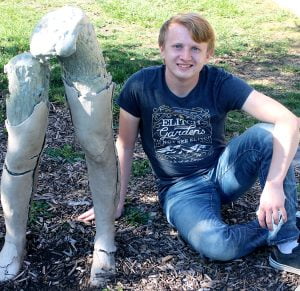One way or another, most materials used to create art come from the natural environment.
Hastings College junior art student Joseph Campell from Columbus, Nebraska, explores that in a sculpture he created for his intermediate sculpture class.

“I wanted to look at humanity and nature and show how everything goes back to the earth,” said Campbell.
While walking past the benches on the south side of the Gray Center, one may notice two sets of legs sculpted from clay and filled with expanding foam.
“The legs aren’t fired,” said Campbell. “This means that it is mud and will dissolve away over time, depending on the weather.”
To create the sculpture, Campbell casted his own legs and then used expanding foam to fill the casts and clay to form the outside shell of the legs. He said the legs could stand from two weeks to two months, but it’s hard to know for sure.
“If it rains, they will dissolve faster, but I’m hoping they will stay until the winter because I would love to see how they look in the snow,” said Campbell.
Campbell said he is curious how his project will stand the test of time, but it wasn’t easy to make something just to let it be destroyed, but he thought his message with the sculpture was important and needed to be shown. “I hope students see, from my sculpture, the impermanence of art and even the impermanence of humanity,” Campbell said, noting that a lot of art is meant to appeal to artists, but he created this to reconnect art to the public.
To hear Campbell talk about his piece, check out the video below.
